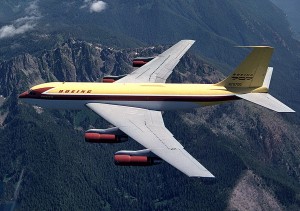
The Boeing 367-80 was the prototype for what became the KC-135 and the Boeing 707. Photo by Boeing.
This is the second part to my interview with Boeing Historian Michael Lombardi. Here is the continuation of our exclusive interview:
AirlineReporter (AR): What do you think the best decision Boeing has made?
Michael Lombardi (ML): I think the best decision was building the Dash 80 (the first Boeing 707), which was a huge risk. People like Bill Allen are such heroes of aviation because of this. They looked down the road and said ’œthe future will be jets.’ We built the B-47 and B-52 and the military has gone in this direction and commercial aviation cannot be too far behind, so let’s give them a little kick in the rear and get them going in that direction.
Boeing took company money and sunk it into building this prototype airplane (the dash 80), and if it had failed, the company would be done. That is why they think of it as a big gamble because financially they put everything into this and so now it was, now we got to make it work and everybody in the company really became focused on, ’œokay, this is the direction we are going, let’s make it happen’.
You have to remember that Boeing at this point is a military company, period. There is no commercial work at all. We are a military company. We are the sole supplier of bombers and missiles to the strategic air command. As a matter of fact, people used to think that SAC (Strategic Air Command) used to mean ’œSeattle Air Command’, because Boeing supplied B-52s, B-47s, Minuteman Missiles, KC97 Tankers, all of these things were invented and given to SAC.
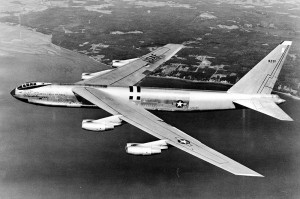
Boeing-made B-52 Stratofortress. Photo by US Air Force
AR: How did Boeing transition from military to commercial?
ML: Boeing told one engineer ’œokay, you go to Europe and sell our airplanes.’ Just one guy, and send him to Europe and tell him ’œgo’, and he’s like ’œI’m designing airplanes, what I am doing?’
There was a lot of learning that had to be done on a completely different business. You have a marketing department that all of a sudden had ’œoh, we have to deal with the public and with the airline customers, how do we do that?’
AR: Marketing must have had quite the challenge.
ML: Boeing had this great advertising campaign where they went right to the public, because they can’t get the airlines interested. So this campaign showed all of these people flying, taking away the fear out of it. Showing children sitting with their folks on the flights and focusing on how smooth a flight on a Boeing aircraft was.
With the older props, people would just wrap themselves in a blanket, get a pillow and wrap it around their heads and just endured the flight because of the vibration and the noise. There was a lot of romance, but there was also a lot to endure. Boeing said, we are going to get rid of all of that, and it’s going to be quiet and it’s going to be smooth, and it’s going to be fast and this is what you wanted people to say, ’œYeah, that’s what we want’.
Then you have Tex Johnson who did the barrel roll, doing his part to get people feeling that jets were safe’¦ that was the whole idea. Before that the British had come out with the Comet and it had a few problems. Because of the comets problems, coming apart at altitude, the public view of jets was that they were just not safe.
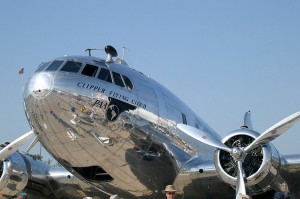
Boeing 307 Stratoliner gave Boeing much needed experience in cabin pressurization. Photo by Sam Wiltzius.
AR: The Comet had to make it hard to get people to trust jets were safe.
ML: The Comet’s problem is it had metal fatigue, the fuselage came apart altitude. This was because of the pressurization, the cycling of fuselage, Boeing had built the first world’s first pressure airplane back in the late 1930’s with the Stratoliner, so of course Boeing had been working on high altitude flight and pressurization for a couple of decades by the time the dash 80 came out.
Whereas de Havilland pretty much built trainer planes and the famous Mosquito during the war and they really didn’t have that much expertise in building big planes. They had gone too far too fast and they didn’t see this coming. The guys from Boeing had been doing their homework for years and developing all of this technology, so they understood all of these issues of cycling of fuselage.
As you remember, we had the Model 307 and the B-29 and the B-52. All of these pressurized planes had come out already.
AR: So how did the Boeing 707 come about?
ML: After the war, Bill Allen, who was running at the company at the time, said we need to diversify. We are too much into one direction with the military. We need to get into commercial, we need to get into space, missile and all of this, so he told his engineering department to start doing all these different things and part of the response was to take the model numbering system and say ’œokay, ’œyou guys working on military aircraft, here’s three and four hundred model numbers keep running with those. You guys over here working on turbine engines take these five hundreds and you guys working on missiles take six hundreds. And all of the work on new transport takes seven hundreds’.
Of course the first transport to come out was the 707 and they went with the 707 because it was catchy and it stuck. The bottom line is that everyone at Boeing focused on this and made it worked. In a few years Boeing turned from being a military company to being a balanced company, to having this commercial airplane business that we are still enjoying the success of today.
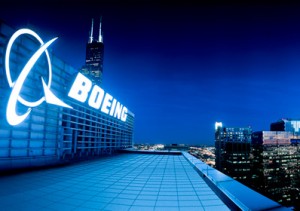
Boeing Headquarters in Chicago,IL. Photo by Boeing.
AR: What do you think was the biggest mistake Boeing made (or the greatest opportunity to learn)?
ML: I think the biggest mistake was when we were building the Boeing 247 and Douglas came out with the DC2 and DC3. We had a customer, TWA headed up by Jack Frye that came to Boeing and said ’œI want 247’s.’ Boeing had our corporate airline, United Air Lines, and they got first dibs. That meant the first 70 airplanes were promised to United Air Lines and when Jack Frye was desperate to have this new airplane for his new airline, he went to Douglas instead. Douglas then came out with the DC3, and the DC3 ended up putting Boeing out of the airliner business until the 707. Their big mistake, was not responding to that customer and they learned from that.
AR: Do you ever go on Wikipedia to make sure they have correct Boeing information?
ML: Every now and then I do. I usually very surprised how knowledgeable people are and there are some smart people out there and aviation enthusiast are passionate’¦ they’re smart, they know how to look stuff up and figure out those little details and the stuff is good. Sometimes I’ll read something and think, ’œWow, where did that come from?’
AR: Alright, my last question will be a doozie: What is the greatest misconception you think people have about Boeing?
ML: One of the things that always bugged me was the term ’œhigh tech company’ we are lead to think of high tech companies as being computer companies or software companies. But there are no other companies that are more high tech than aerospace companies like Boeing.
We are high tech. We are the people that invented computers, the software, and all of this stuff came out of the aerospace industry. All the high tech industries are all an off shoot of the aerospace industries, so I think that has always been a misconception.
When you think of who’s high tech and who’s pushing the boundaries it really is the aerospace industry and Boeing. The internet is cool, and having computers and your little 4G phone is great, but it’s not worth a dang thing without those satellites and the technology that we developed to make that happen, with the GPS all that business. All stuff that was created by this industry and that is one of the things that people need to know.
Inside The Boeing Company Archives
PART 1 | PART 2 | PART 3a | PART 3b | ALL PHOTOS | ALL STORIES
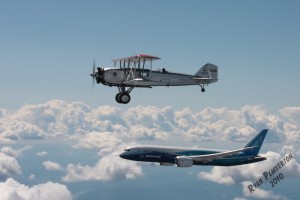
Boeing's oldest (Model 40) and newest planes (787 Dreamliner) flying together. Photo by Ryan Pemberton.
Here is the long awaited part 3 of my inside look at the Boeing Archive. I apologize it has taken so long to get this published.
In part 1 I took a look at what is inside the Boeing Archive. Then part 2, I took a closer look at some of the models in the Boeing archive. Now, I will post my interview with Boeing Historian Michael Lombardi. What is amazing is Lombardi did our whole interview from memory. I broke our interview it into two parts, with the second one posting tomorrow. Enjoy is our exclusive interview:
AirlineReporte (AR): How long have you been the Boeing Historian?
Michael Lombardi (ML): I’ve been doing the History thing for 16 years.
AR: You have to realize that you have one of the coolest jobs in the world, right?
ML: Well, I was sitting with Mike Carriker, Chief Flight for the 787 and I always joke that, well I have second best job in the world.
AR: How the heck did you get this job?
ML: I was really blessed to get this job and more of a case of being at the right place at the right time. The archives used to be with our technical libraries and I worked with them and the manager knew how much, like yourself, how much of a passion I had for aviation and having studied history and such and she said, ’œyou’d be great for this job. You need to go on and apply for it’. And I wasn’t even aware that the historian was retiring, so of course, I always thank this now retired manager profusely for doing this because I thought that was very forward looking and being a good manager and saying ’œhey, I think this employee would be a good fit for the position’.
AR: Do you have a staff?
ML: Yes, I have a very small staff. It’s me and Tom, and that is who’s here and we have a historian archivist in southern California and one in St. Louis. So there are four of us. Tom and I work for Boeing Communications and our two other historians work for the defense side of the company.
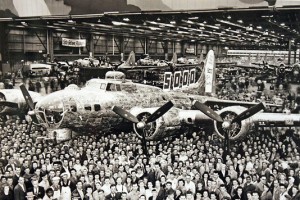
Employees gather with the 5000th Boeing B-17 made at Plant 2 in Seattle during WWll. Photo by Boeing.
AR: Knowing Boeing’s past pretty well, where do you see Boeing’s future?
ML: I think one thing you see is that the company will continue to lead the way as far as what’s the next step. And throughout history it seems that Boeing has introduced the products and technology or the innovations that have pretty much defined where flying is going to be, where travel is going, how airplanes are going to be used, or space vehicles. The company has been a leader throughout history and I don’t think that’s going to change.
AR: What is something that amazes you about Boeing?
ML: One of the things that always amazes me are the people that work here are so smart’¦ sometimes it just makes you say ’œwow’. And it makes you think, ’œHow can we not do the coolest things in the world?’ And then given with leadership that just says, ’œDo what you need to do and we’ll support you and give you the tools that you need and the support’¦’ and when you have that kind of leadership, the future is just completely open. I think it’s really cool.
AR: How do you think that William Boeing, the founder of Boeing, would view the company today?
ML: I think he would be very pleased with the company. His thing was that he wanted the company to constantly looking at new ideas and doing research, and doing development and always being at the forefront of aviation; bringing together all of the ideas and all of the newest ideas, and being a pioneer. That was a big thing for him. And I think that spirit it still here and that is what keeps the company going, it’s that pioneering spirit.
AR: Boeing used to run their own airline and many people ask, ’œWhy doesn’t Boeing have an airline today?’
ML: That’s a great question. A lot of it has to do with the laws about people who make airplanes shouldn’t be flying them too. So, that was pretty much it. In 1934 the government passed laws where the airplane manufactures couldn’t own airlines. So this kind of broke up what Bill Boeing had started.
It’s pretty amazing what he had done. They had the small airplane company here in the northwest in Seattle. And he was pretty successful but it was a small company, so what was the next big step? How do you expand this business and this is one thing to remember about Bill Boeing, is that he was a businessman. He wasn’t like a lot of pioneers out there that started the aerospace industry, a lot of them where engineers and some designers and they built an airplane and started a company. Bill Boeing looked at the airplane as a business.
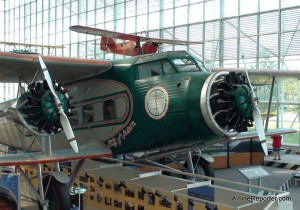
Boeing 80A-1 with "Boeing Air Transport" located at the Museum of Flight.
He was pretty visionary. You look at the articles of incorporation and he said that airplanes are going to be used for commerce, and for business travel, and passengers, and I want to have schools to train pilots and all of this. And at that time people looked at airplanes as a curiosity and there was no idea that you should fly an airplane on a trip and no one had conceived of that at that time.
You get up to 1927 and Bill Boeing decides to expand his business and goes into the airmail route, from Oakland, CA to Chicago, the biggest one in the country at the time. To do that, he had to give a low bid, and created the Model 40, which used an air cooled radial engine. Where other airplanes were water cooled and very heavy because they are carrying the water for the engine, the Model 40 was lighter and carried more mail, so Boeing won the contract. And this is the start of Boeing Air Transport. With that airline, he’s a businessman and he goes out and buys other airlines to make his airline bigger and then he’s like ’œwe need engines for airplanes’ so then he goes to Frederick Rentschler and says ’œI want Pratt & Whitney to become part of my company’ and they merge together. Everything under one roof. Great idea, right? And because of that Boeing goes out and builds airports and starts all these routes. There’s a couple other airline pioneer companies out there as well, but some of the things that Boeing did was design safety features and radios communication and ways to guide airplanes. Bill Boeing started this aviation infrastructure throughout the country and a lot of people forget that – that there really is a debt owed to Bill Boeing for doing that.
AR: Was there ever resistance to this new air-industry?
In 1934 you had a change in government, and of course the depression, and during the depression you have the airline industry just cooking along like nothing’s wrong and they’re making money and they are very successful’¦ so, they must be doing something illegal. Think about our recent history, which isn’t a whole lot different than back in the 1930’s, the car industry, the executives being called up in front of congress and those congressmen going ’œgrrr’ and the grandstanding in front of them. The same thing happened in 1934 but at that time you had Bill Boeing being rushed up there and being scolded.
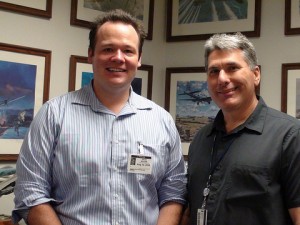
Mike Lombardi and me inside the Boeing Archives.
But at that time he had Charles Lindbergh, who is this public hero. You know the greatest guy in the world. American’s love him, and he gets up there and tells congress, ’œYou guys are all wrong. These guys have given you this wonderful gift of an airline infrastructure’, they have connected America with airplanes and you can go anywhere to do commerce and business, and this is something you need to thank them for. So that kind of stopped that whole bit. The result was they passed laws that said, they were going to break up these big holding companies. United Aircraft & Transport was broken up and because his big empire was being broken up, he just said ’œYou know, I’m tired of this. You hauled me in front of congress and you are calling me a liar’¦’ and he was a gentleman and a man of his word, very ethical. To call him this name was a very big offense to him and his character. And he said ’œI’m done with it’. And he’s already a rich man when he starts the company, this was business interest, it wasn’t his livelihood.
AR: It seemed really interesting to me that he got out pretty quick. He could have stuck around.
ML: He’s only around for about 18 years. He leaves the company and the company is broken up. You get the Boeing Company with the Wichita Stearmen division is made up into one part of the company. Everything on the east coast with Pratt Whitney, Sikorsky, and Hamilton Standard and all these other small companies like Chance Vought are all clumped together in this company called United Technologies. This is still around today. And then all of the airline interests are all previously called United Transport Corporation, are now called United Air Lines, which is now United Airlines. So these three big aerospace concerns that are still around and most of them are still very successful are companies started by Boeing. This is pretty amazing.
AR: It is amazing to think about how many companies have come and gone since then.
ML: The guy was really like the Bill Gates of his day. He was this amazing businessman.
Tomorrow I will post our interview where Lombardi talks about what he feels the best and worst decisions Boeing has made, as well as other interesting facts.
Inside The Boeing Company Archives
PART 1 | PART 2 | PART 3a | PART 3b | ALL PHOTOS | ALL STORIES
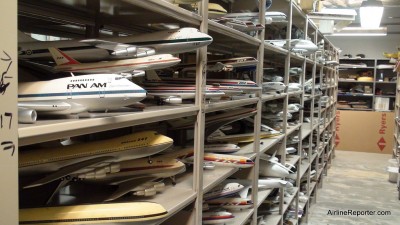
How would you like to have this airline model collection located in the Boeing Archive? Um, yes please.
A while back I had the amazing experience of checking out Boeing’s archive located in Bellevue, WA. My first post in September gave the general overall look at the archives. Unfortunately since then, I got distracted with other things and caused a delay. This post will be going over the models (airplane not people) found in the archives and next week I will be posting my interview with Boeing Historian Michael Lombardi.
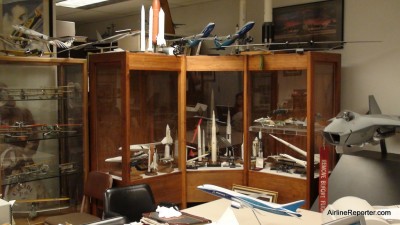
These are just some of the models located in the lobby of the Boeing Archive. They keep the real good ones locked up.
When I went for my visit in September, I was expecting the archives to be a bunch of boxes on shelves. One of the best surprises were all the amazing and unique models housed in the archives. From single aisle Boeing 747 mock ups to Boeing boats, I felt like a kid in a candy store needing a sugar rush. The archive has so many models, it has been difficult to store them all. I told Lombardi that I would be more than happy to store some at my house, but I don’t think that will work out. Although some models were spread around in the lobby and on random shelves, most were stored in two long rows of shelving. There were military and commercial airline models, but of course my main interest were the airliners.
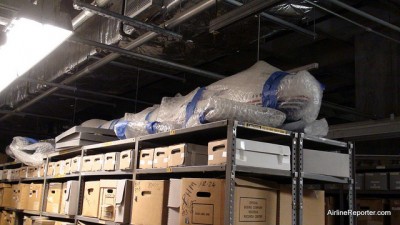
I got so distracted by learning about the Boeing boats, I forgot to take a photos. But I did catch this HUGE Boeing 747 model.
Did you catch I said “Boeing boats” earlier? I am not talking about the Boeing 314 Flying Clipper, I am talking about real boats. Using their knowledge from aerodynamics, Boeing dove into the world of hydrofoil/jetfoil boats. They first launched in 1962 and built boats for military and commercial use until 1988 when Boeing Marine Systems closed and sold the license for the Commercial Jetfoils to Kawasaki Heavy Ind. Lombardi tells me that some Boeing Jetfoils are still “flying” to Macao and between Korea/Japan.
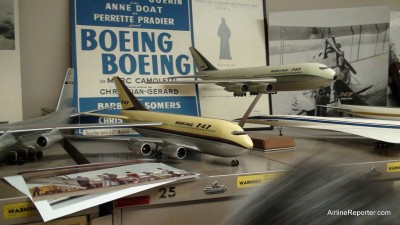
Two single aisle, double deck mock ups for the original Boeing 747.
When Boeing was looking at making a larger aircraft after the Boeing 707, they played with the idea of a double-decker, singled-aisle airplane like these two models depicted above. Can you spot the differences (larger version)? One has the wings in the middle of the fuselage, the other a bit higher. Also check out the differences in landing gears. These models look much more like the Airbus A380 than they do the Boeing 747. You can really see the nose of the Boeing 707/727/737 in the white model. Also, do not miss the Boeing SST model, there were quite a few of those spread out around the archive.
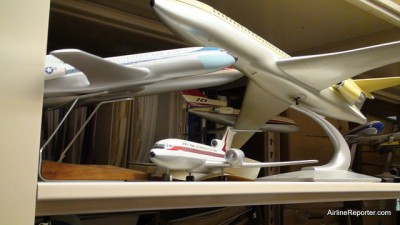
This is one odd-looking potential Boeing 727
This little guy (seen above) was hard to spot amongst all the models, but looked very interesting. Lombardi explained what the function of the engines being placed on the wings. “During the 1970s Boeing studied all aspects of commercial aviation and also reviewed the entire commercial family to see what could be improved. This model of the 727 shows one of those considerations it is a STOL 727 using a concept called USB or upper surface blowing. USB was successfully tested on the Boeing QSRA and the Boeing YC-14.” The Boeing 727 is one of my favorite airliners since it looks so majestic. I don’t think I would have the same love if it looked like the model above or like this other funky looking 727 model.
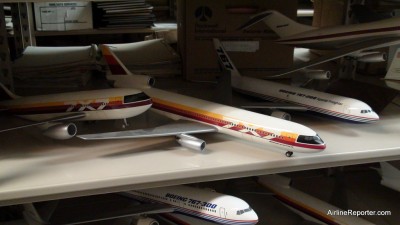
These show what Boeing was looking at with the Boeing 767.
There was a pretty big section of Boeing 767 prototype models in the Boeing archive. There were ones that closely resemble what became the Boeing 767 and others that looked… well, unique. Boeing was playing with the idea of making the 767 being a quad or even tri-jet aircraft. Probably the most interesting Boeing 767 prototype is the one you can see on the right on the photo above and detailed in the photo below.
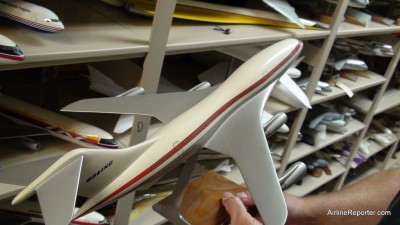
Check out the sweet waistline on this possible Boeing 767 design.
This was one of my favorite models. That slick waist-line shape would have allowed the plane to travel at near sonic speeds. Lombardi explained why it wasn’t chosen. “Much like the Sonic Cruiser and it did not go forward for the same reasons that the Sonic Cruiser did not go forward – the fuel burn increases dramatically at near sonic/transonic speeds because of the increased drag.” I would imagine the seat layout on the interior would have been interesting and a bit cumbersome.
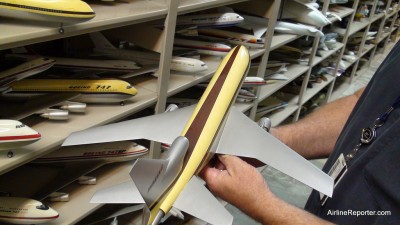
A model of the Boeing 747 Tri-Jet at the archive.
No matter how many times I have seen the mock ups, the Boeing 747 TriJet always looks odd to me. During the 1970’²s Boeing wanted to better compete with the DC-10 and L1011. The Boeing 747SP was too costly to directly compete, so for a short while, Boeing looked at creating a 747 with three jets instead of the standard four. The design has two jets on the wing and one on the tail in an ’œS’ configuration, much like the L1011. The concept was scrapped since it would take too much time, money, and a new wing design.
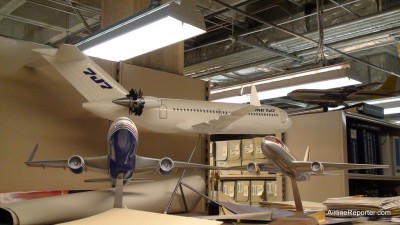
Ah, the Boeing 7J7. Wait a second... is that a Boeing 767 with foldable wings?
The Boeing archive wouldn’t be complete without a model of the Boeing 7J7. This aircraft was designed in the 1980’s with the idea of replacing the Boeing 727. It used Unducted Fan Engines on the rear of the plane that provided superior fuel economy. Boeing hoped the 7J7 would burn about half the fuel of the Airbus A320 and hoped to revolutionize commercial air travel. A reduction in oil prices and noise concerns ended up killing off the 7J7. Might we see another version of the UFE in the future? I am going to bet on yes.
Be sure to take a look at all 44 photos taken of the Boeing archive.
Inside The Boeing Company Archives
PART 1 | PART 2 | PART 3a | PART 3b | ALL PHOTOS | ALL STORIES
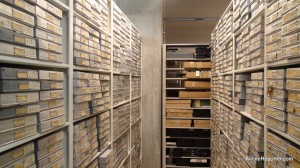
Inside the Boeing Archive. These are all films from Boeing's past. How awesome would it be to watch them all?
Boeing is one huge company. Currently, they have about 160,000 employees that do things from building planes to cleaning windows. The Boeing Company was first established in 1916 and has such an amazingly interesting history. What does a company like Boeing do to keep their history intact and make sure great ideas don’t fall between the cracks? I didn’t know, but I wanted to find out.
Recently I was fortunate enough to be invited to take a tour of the Boeing Archive and sit down with Boeing Historian Mike Lombardi. Since there was so much information to see and learn, I will present what I discovered in the archives in a three part series. In this first part, I will talk about the archives. Then in part two, I will share with you all the incredibly preserved Boeing models they have there. Finally, I will share my interview with Lombardi.
Even though most people associate Everett (Paine Field) and Renton (where 737’²s are made) with Boeing in the Seattle area, the archives are housed in a Boeing complex in Bellevue, WA, which is located just east of Seattle. The archive in Bellevue is the main corporate archive and preserves the history of Boeing and the aviation history of North American/Rockwell. The archives are for current commercial business as well as Boeing corporate.
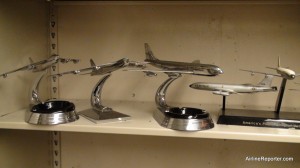
In the Vault: these classic Boeing ashtrays, which were very popular with Boeing engineers back in the day.
Over the years, the archive has grown to include other locations across the nation. There are the Douglas archives in Cypress, CA (near Long Beach), where the history of Douglas is preserved as well. It also houses Boeing’s current space and electronics related businesses that are in southern California. Boeing’s archive in St Louis takes care of the history of McDonnell Douglas and Hughes helicopters and supports their current military aircraft and defense business.
I was quite fascinated with the multiple levels of security attached to the Bellevue archive. First, guests must check-in at a public building to get their ’œEscort Required’ badge. Then, it is through a security gate where guests have to show said badge with their escort (who, for me, was the very helpful Bernard Choi with Boeing Communications). After the second security check, there are various doors one must go through that require a code before they reach the basement archives.
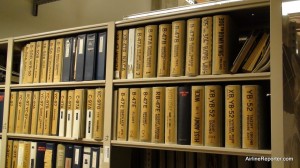
How cool would it be to have a few weeks to sit down and read all these?
Most of Boeing’s history is housed in an earthquake resistant basement, where computer chips used to be made. There are long rows of boxes with models (which I will talk about in Part 2), posters, films and trinkets almost everywhere. I was surprised. I was expecting just to see rows and rows of boring brown boxes, but there was a lot of great eye candy.
Inside another door to the side of the archives is a long room that is constantly air conditioned. In this room, one can find thousands of Boeing videos of pretty much everything Boeing has done since video was created. They are mostly on old school film. They have information on 16 and 35mm motion picture film, 35mm microfilm, VHS, 1’³ tape, 1/2 tape, 2’³ tape, Betamax, DAT, CD, DVD and Laser Disc. That isn’t even all the formats. Boeing is in the process of converting many of these items into digital formats.
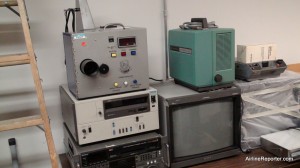
The Boeing Archives needs to keep a lot of classic viewing machines around.
What a job it would be to watch the videos to convert them over?! I did hint to Bernard what a GREAT TweetUp it would make to show a few of these old videos (Boeing 707 test videos anyone) to the general public. Not only does Boeing keep all the old formats, but they also must hold on to all sorts of format players. From 8-tracks to Laser discs, they have a vast collection of media players that could serve as its own mini-museum.
After checking out the videos, I got to check out the vault. Another locked room in a series of locked rooms. I would love to tell you what was in the vault but I can’t, but let me tell you, it was amazing.
Ok, I am joking, I can tell you what was in the vaultpretty much all the prized possessions of Boeing’s past. Some of the items include gifts given to them by world leaders and items gathered by previous Boeing leadership. Also found in the vault are the meeting minutes dictating all the decisions ever made by Boeing and very valuable Boeing memorabilia. It was at this point I made the joke about how much all this stuff would sell for on Ebay. Heh, Mike didn’t find it funny (ok maybe a little bit). Mike has a heart for all things that are Boeing and he hates seeing important trinkets being sold on Ebay for money. Many families of Boeing employees who pass away will happily donate their loved ones Boeing items to be preserved in history. Mike told me he often gets emails from people trying to sell Boeing items, thinking they have deep pockets, but Boeing is not in the business of buying memorabilia.
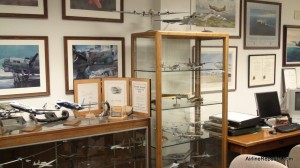
The Boeing Archive lobby had quite a few models, but that was nothing compared to what was inside the archives.
The archives are not just there to keep a hold of history. They are also there to help the future. Boeing engineers will often come to the archives so they don’t need to reinvent the wheel. If a Boeing engineer created a solution to a problem 30 years ago, current engineers can take a look at the old research and save time and money building off previous work.
So how does the general aviation nerd get access to the archives? Well the quick answer is that you can’t. They allow visits by non-Boeing guest on an extremely limited case-by-case basis. It is limited to academic researchers, the media, Boeing customers, museum staff, and established authors. However, enthusiasts can access Boeing archival information through the Boeing Images website. With Boeing making more of their archives digital and making more of an effort to connect with fans, we can hope that more of the fun stuff will be made public.
Even though I got to spend over an hour in the archives, I could have easily spent years without getting bored. Tomorrow, in Part 2, I will be posting about all the amazing models that are housed in the archives. In part 3, I will post an interview with Mike about his job and his thoughts on Boeing’s past, present and future. Stay tuned!
Inside The Boeing Company Archives
PART 1 | PART 2 | PART 3a | PART 3b | ALL PHOTOS | ALL STORIES





















